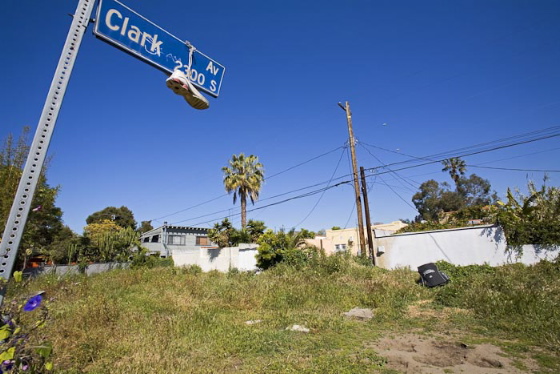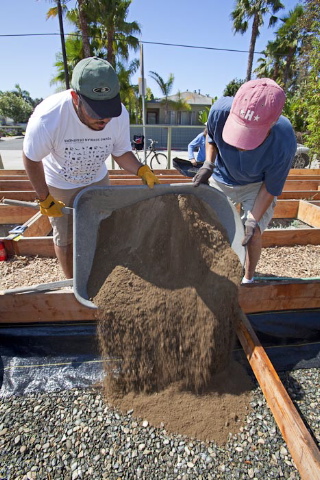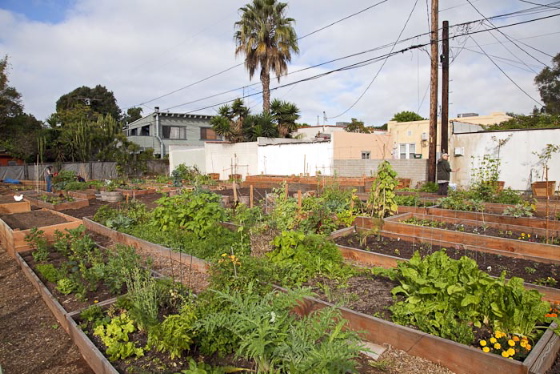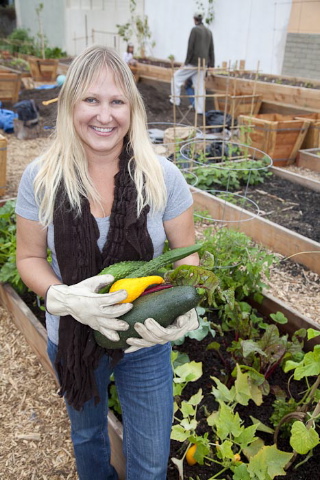Venice Community Garden - From the Ground Up
Not long ago, an empty lot in Venice, California, just a few blocks from the Pacific Ocean, was overgrown with weeds. In it there was an old jet ski that was left to rust along with old auto parts scattered around on soil mounds. Years before that, railroad tracks ran through the center of this plot of land on Mildred Ave. Freight cars transporting their goods and perhaps tanker cars carrying oil from the surrounding wells, made their way along these tracks in what is now a peaceful and typical Venice residential community. The story of a garden is the story of its soil, and those of us living in urban environments are surrounded by land and soil that has had many and multiple uses. The soil can tell us the history of that land, something that is imperative to know if we want to plant our gardens and eat our food with surety and safety. The Venice Community Garden that is now on that plot of land on Mildred Ave. was started by some residents who had the simple idea of starting a garden, where members of the community could grow and eat the food they planted. What they discovered along the way was a little about history, a lot about soil, and ultimately a deeper understanding of what it means to grow.
Starting
Kip Wood has lived in Venice for about nine years and had developed an interest in gardening, mostly from working in his own front yard, noting he “liked getting his hands in the ground.” Inspired by some classes he took from David King at Venice High School’s Learning Garden, and surprised that there were no community gardens in Venice, he decided that to start one himself. His intention was to design a beautiful space, with trees and art - a place where people could come together, plant food and get their hands dirty. In January, 2010 he noticed a ‘for lease’ sign at an empty lot around the corner from his home. The property had been sitting vacant for some time, so when Kip inquired about it, the landlord was only too happy to lease it to Kip for a garden.
Kip initially worried about getting enough interested people. Unlike some community gardens that are on donated or city property and who only charge their members a low yearly fee, a minimum of about 48 people were going to be needed to pay the $25 a month for rent and expenses. Flyers were distributed and emails to a gardening list brought in some interest, but a post on Yo! Venice!, a neighborhood web forum, elicited a tremendous response and there was soon a waiting list of about 200 people.
Norma Bonilla was one of the first to respond. Norma had also taken some classes at the Learning Garden and was inspired to move her life in a new direction. She had owned several businesses over the years, in architecture, remodeling and design, and with those skills and her management abilities, immediately got involved in the planning of the garden along with Kip. Working together, things started to progress.
Preparation
One of the first things Kip and Norma did was to download a copy of the Community Garden Start-up Guide from the University of California Cooperative Extension’s website (see sidebar), and used it to help create their own to do list. They started to hold meetings to help garden members get to know each other and to take on needed tasks. Plot assignments were given out and members signed a Plot Holder Agreement with the garden’s rules put forth. Liability Insurance was obtained to protect the landowner. Permits were not needed as residential zoning in Los Angeles allows for the growing and selling of fruits and vegetables.
Kip’s Initial schematic called for 48 plots in the six thousand square foot lot, most of them 12 by 4 feet. New trees and shrubs, donated by a local environmental group, Tree People, would line the back wall as well as a central interior space to be used for meetings and workshops. A fence was also planned for, a suggestion the start-up guide recommended to cut down on vandalism. Money was raised for the needed hardware, plumbing, lumber and other supplies through donations by members and the contributions from local merchants.
Getting a water meter installed would have been the best method of water access, fees are generally pretty low if there are pipes already installed, however the lot had no pipes and installing them was going to be too expensive, around $3,000. Eventually it was determined that sharing water with the gardens’ neighbor, who happened to have the same landlord, was the easiest and cheapest recourse.
Irrigation expert Deni Friese from UCCE Common Ground Master Program helped design the new watering system. She recommended a water line straight down the center of the garden with four hose bibs on risers for manual watering. A drip or any other kind of irrigation system was not considered, as it was decided that it was important for everyone to learn how to tend and water his or her own garden. As Norma put it, “we are growers, it is about the connection with our own land and plants, not about putting it on a timer.”
Breaking Ground.
Initial soil testing revealed high levels of lead and arsenic, so it was decided to remove the top layer of soil. Lead can be found in many urban and suburban environments as the result of automotive parts and emissions, pesticides, paint chips and plumbing. Even though the use of lead in many of these products has been outlawed for decades, the residue can linger in soil for many years after it has been exposed.
The arsenic was attributed to an old rail line that was found to have run directly through the lot. It was common to spray massive amounts of herbicide, which contained arsenic, next to the rail ties to prevent weeds from obstructing the train tracks.
On April 13, 2010 the garden broke ground and a loader began removing the soil from the garden. With each pass, the contaminated soil, rocks and debris gave way to smooth hardened clay which was then tilled with additional passes by the tractor. The huge pile of dirt was carted away and what was an empty lot was now on its way to becoming a garden.
With construction of the planting beds about to begin, Kip and Norma called on the LA Conservation Corps for help, an organization that helps at-risk youth by providing education and job skills training through neighborhood service and conservation projects. The lot was staked out and the LACC troops got to work. A local market even donated sandwiches for the hard workers. The beds were finished in a few days, it was the end of May.
There was still some glass and asphalt on the top surface, so as a precautionary measure, garden members were advised to dig an additional one-foot deeper in their beds. It was also suggested that members take one last soil sample for testing from three different areas in their planting beds. The last mounds of removed soil were carted away, spirits were high and planting was about to begin.
Then one night, Kip and Norma got a call. Some of the new soil tests came back with high levels of lead and arsenic, after all the work and digging, the toxins were still present in the soil. According to Garn Wallace of Wallace Labs “It is not recommended to grow leafy green vegetables in soils that contain lead above 30 parts per million (ppm) or arsenic with over 2 ppm.” Over half the plots had come back with high levels of one or both.
Setbacks and solutions
Kip and Norma were devastated and several members even left the garden. The project was put on hold and things seemed bleak. Then “something very special happened” said Norma, “emails started to come in from members urging us to keep going. The letters were so supportive and just what we needed to move forward on this beautiful space.” They encouraged research and many offered their assistance to seek the necessary solutions. A multi-tiered solution was decided on, and by Mid-July activity began again.
Digging deeper would probably bring similar results, so it was decided to bring in new soil and then use multiple layers to keep the plants protected from the toxins. First a bed of rocks, three inches deep, would be placed at the bottom of the planting beds. This would keep roots from reaching the contaminated soil, but would allow for water drainage. Sprinkling gypsum power over the rocks and then lightly watering it would break down the hard clay soil below the rocks, further enhancing drainage and allowing for micro organisms and worms to thrive.
Next a one-foot wide 3.5 mil sheet of plastic would be stapled around the circumference of the raised planting beds, which would prevent the toxins leaching in to the beds during rainfall and watering. Lastly, a slightly wider sheet of weed cloth would be stapled over the plastic sheeting to keep the roots from tearing holes in it and reaching the toxic soil. Woodchips are placed around the walkways to keep lead dust from spreading and to help eventually amend the soil.
Finally the new soil could be added. Several mounds of sandy loam soil were delivered and members used it to fill half their beds. Soon after, compost, available for free from the city, was brought in and the other half of the planters were filled and mixed together with the soil.
Planting and Harvest
Planting finally began in August. A moment many thought would never come had finally arrived after what seemed an eternity. Los Angeles is of course fortunate to have year round growing, the question for many was whether or not to plant seeds or seedlings. Some opted for just seeds, but many planted a combination of both.
Denise and Frank are a young couple who work in advertising. Both had experience with gardening and were on the waiting list of other community gardens when the Venice Garden plot became available. On their first day of planting, Frank was carefully placing small snow pea seeds around the berms they had built in their bed. About 70% of their plantings were seedlings, amongst them, cucumbers, radishes and cherry tomatoes.
Jennifer is an experienced farmer from Oregon, recently arrived in Los Angeles. The garden helped her find an attachment to the community through gardening. Facing some health challenges, she has found gardening helps reduce stress and is meditative. Her physical therapist has even given her exercises and stretches based on garden activities such as watering and planting.
Aeryn and Isabel share a plot and are both studying landscape architecture While being members of the garden is relevant to their work, according to Isabel, it is also a place to “meet your neighbors and learn from everyone else.” The care in which they approached their planting bed was evident, their plantings were intentionally a diverse selection of low, medium and high growth seedlings. Aeryn said they also tried to be mindful of the color palette when they chose their flowers and vegetables.
They were one of the first to plant and so were one of the first to harvest their crop. By mid October, their bed was a robust display of colorful vegetables. Aeryn began clipping off zucchinis as large as footballs along with bright yellow squash, swiss chard and cucumbers. She held up her bounty and she smiled at what was their obvious success.
On a Saturday morning, a group of people gathers around to hear Norma give the first of the workshops she has planned. Passerby’s continually walk by the garden and peer in curiously. There is now so much activity and growth in a place that for years residents had ignored as an ugly vacant lot. The garden is now beautiful, but just as importantly, the work everyone did will ultimately leave the soil in better shape than when they found it. Both land and people will be transformed from a community coming together, learning together and growing together.




